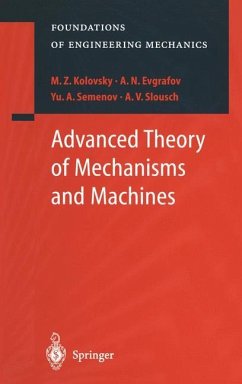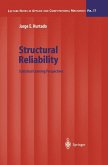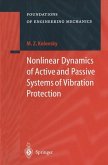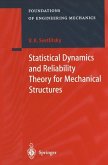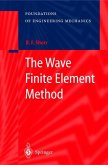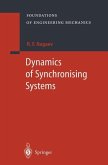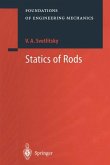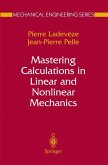M.Z. Kolovsky, A.N. Evgrafov, Yu.A. Semenov
Advanced Theory of Mechanisms and Machines
Übersetzung:Lilov, L.
M.Z. Kolovsky, A.N. Evgrafov, Yu.A. Semenov
Advanced Theory of Mechanisms and Machines
Übersetzung:Lilov, L.
- Broschiertes Buch
- Merkliste
- Auf die Merkliste
- Bewerten Bewerten
- Teilen
- Produkt teilen
- Produkterinnerung
- Produkterinnerung
This book is based on a lecture course delivered by the authors over a period of many years to the students in mechanics at the St. Petersburg State Technical University (the former Leningrad Polytechnic Institute). The material differs from numerous traditional text books on Theory of Machines and Mechanisms through a more profound elaboration of the methods of structural, geometric, kinematic and dynamic analysis of mechanisms and machines, consisting in both the development of well-known methods and the creation of new ones that take into account the needs of modem machine building and the…mehr
Andere Kunden interessierten sich auch für
![Structural Reliability Structural Reliability]() Jorge Eduardo HurtadoStructural Reliability115,99 €
Jorge Eduardo HurtadoStructural Reliability115,99 €![Nonlinear Dynamics of Active and Passive Systems of Vibration Protection Nonlinear Dynamics of Active and Passive Systems of Vibration Protection]() Michail Z. KolovskyNonlinear Dynamics of Active and Passive Systems of Vibration Protection75,99 €
Michail Z. KolovskyNonlinear Dynamics of Active and Passive Systems of Vibration Protection75,99 €![Statistical Dynamics and Reliability Theory for Mechanical Structures Statistical Dynamics and Reliability Theory for Mechanical Structures]() Valery A. SvetlitskyStatistical Dynamics and Reliability Theory for Mechanical Structures115,99 €
Valery A. SvetlitskyStatistical Dynamics and Reliability Theory for Mechanical Structures115,99 €![The Wave Finite Element Method The Wave Finite Element Method]() Boris F ShorrThe Wave Finite Element Method107,99 €
Boris F ShorrThe Wave Finite Element Method107,99 €![Dynamics of Synchronising Systems Dynamics of Synchronising Systems]() R.F. NagaevDynamics of Synchronising Systems115,99 €
R.F. NagaevDynamics of Synchronising Systems115,99 €![Statics of Rods Statics of Rods]() V.A. SvetlitskyStatics of Rods67,99 €
V.A. SvetlitskyStatics of Rods67,99 €![Mastering Calculations in Linear and Nonlinear Mechanics Mastering Calculations in Linear and Nonlinear Mechanics]() Pierre LadevèzeMastering Calculations in Linear and Nonlinear Mechanics82,99 €
Pierre LadevèzeMastering Calculations in Linear and Nonlinear Mechanics82,99 €-
-
-
This book is based on a lecture course delivered by the authors over a period of many years to the students in mechanics at the St. Petersburg State Technical University (the former Leningrad Polytechnic Institute). The material differs from numerous traditional text books on Theory of Machines and Mechanisms through a more profound elaboration of the methods of structural, geometric, kinematic and dynamic analysis of mechanisms and machines, consisting in both the development of well-known methods and the creation of new ones that take into account the needs of modem machine building and the potential of modem computers. The structural analysis of mechanisms is based on a new definition of structural group which makes it possible to consider closed structures that cannot be reduced to linkages of Assur groups. The methods of geometric analysis are adapted to the analysis of planar and spatial mechanisms with closed structure and several degrees of movability. Considerable attention is devoted to the problems of con figuration multiplicity of a mechanism with given input coordinates as well as to the problems of distinguishing and removing singular positions, which is of great importance for the design of robot systems. These problems are also reflected in the description of the methods of kinematic analysis employed for the investi gation of both open ("tree"-type) structures and closed mechanisms.
Produktdetails
- Produktdetails
- Foundations of Engineering Mechanics
- Verlag: Springer / Springer Berlin Heidelberg / Springer, Berlin
- Artikelnr. des Verlages: 978-3-642-53672-4
- Softcover reprint of the original 1st edition 2000
- Seitenzahl: 408
- Erscheinungstermin: 30. August 2012
- Englisch
- Abmessung: 235mm x 155mm x 23mm
- Gewicht: 623g
- ISBN-13: 9783642536724
- ISBN-10: 3642536727
- Artikelnr.: 39157850
- Herstellerkennzeichnung Die Herstellerinformationen sind derzeit nicht verfügbar.
- Foundations of Engineering Mechanics
- Verlag: Springer / Springer Berlin Heidelberg / Springer, Berlin
- Artikelnr. des Verlages: 978-3-642-53672-4
- Softcover reprint of the original 1st edition 2000
- Seitenzahl: 408
- Erscheinungstermin: 30. August 2012
- Englisch
- Abmessung: 235mm x 155mm x 23mm
- Gewicht: 623g
- ISBN-13: 9783642536724
- ISBN-10: 3642536727
- Artikelnr.: 39157850
- Herstellerkennzeichnung Die Herstellerinformationen sind derzeit nicht verfügbar.
1 Structure of Machines and Mechanisms.- 1.1 Machines and Their Role in Modern Production.- 1.2 Structure of a Machine and its Functional Parts.- 1.3 Mechanisms. Links and Kinematic Pairs.- 1.4 Kinematic Chains and Structural Groups. Generation of Mechanisms.- 1.5 Mechanisms with Excessive Constraints and Redundant Degrees of Movability.- 1.6 Planar Mechanisms.- 1.7 Mechanisms with Variable Structure. Strucural Transformations of Mechanisms.- 1.8 Examples of Structural Analysis of Mechanisms.- 1.9 Problems.- 2 Geometric Analysis of Mechanisms.- 2.1 Problems of Geometric Analysis.- 2.2 Geometric Analysis of Open Kinematic Chains.- 2.3 Derivation of Equations of Geometric Analysis for Closed Kinematic Chains.- 2.4 Solution to the Equations of Geometric Analysis.- 2.5 The Inverse Problem of Geometric Analysis.- 2.6 Special Features of Geometric Analysis of Mechanisms with Higher Kinematic Pairs.- 2.7 Problems.- 3 Kinematic and Parametric Analysis of Mechanisms.- 3.1 Kinematic Analysis of Planar Mechanisms.- 3.2 Kinematic Analysis of Spatial Mechanisms.- 3.3 Kinematic Analysis of a Mechanism with a Higher Pair.- 3.4 Kinematics of Mechanisms with Linear Position Functions.- 3.5 Parametric Analysis of Mechanisms.- 3.6 Problems.- 4 Determination of Forces Acting in Mechanisms.- 4.1 Geometric Conditions for Transmission of Forces by Mechanisms.- 4.2 Determination of Forces Acting in Mechanisms by the Graph-Analytic Method and the Method of Opening Kinematic Chains.- 4.3 Application of Equilibrium Equations of a Mechanism to its Kinematic and Parametric Analysis.- 4.4 General Formulation of the Force Analysis Problem.- 4.5 Equations of Kinetostatics. Determination of the Resultant Vector and of the Resultant Moment of Inertia Forces of Links.- 4.6 Solution of the Equations of Kinetostatics.- 4.7 Application of the General Equation of Dynamics for Force Analysis of Mechanisms.- 4.8 Force Analysis of Mechanisms with Higher Kinematic Pairs.- 4.9 Problems.- 5 Friction in Mechanisms.- 5.1 Friction in Kinematic Pairs.- 5.2 Models of Kinematic Pairs with Friction.- 5.3 Force Analysis of Mechanisms with Friction.- 5.4 Problems.- 6 Equations of Motion for a Mechanism with Rigid Links.- 6.1 Lagrange's Equations of the Second Kind for a Mechanism with a Single Degree of Movability.- 6.2 Lagrange's Equations of the Second Kind for Mechanisms with Several Degrees of Movability.- 6.3 An Example for Derivation of the Equations of Motion of a Mechanism.- 6.4 Problems.- 7 Dynamic Characteristics of Mechanisms with Rigid Links.- 7.1 Internal Vibration Activity of a Mechanism.- 7.2 Methods of Reduction of Perturbation Moments.- 7.3 External Vibration Activity of Mechanisms and Machines.- 7.4 External Vibration Activity of a Rotating Rotor and of a Rotor Machine.- 7.5 Balancing of Rotors.- 7.6 Vibration Activity of a Planar Mechanism.- 7.7 Loss of Energy due to Friction in a Cyclic Mechanism.- 7.8 Problems.- 8 Dynamics of Cycle Machines with Rigid Links.- 8.1 Mechanical Characteristics of Engines.- 8.2 Equations of Motion of a Machine. State of Motion.- 8.3 Determination of the Average Angular Velocity of a Steady-State Motion for a Cycle Machine.- 8.4 Determination of Dynamic Errors and of Dynamic Loads in a Steady-State Motion.- 8.5 Influence of the Engine Dynamic Characteristic on Steady-State Motions.- 8.6 Starting Acceleration of a Machine.- 8.7 Braking of a Machine.- 8.8 Problems.- 9 Dynamics of Mechanisms with Elastic Links.- 9.1 Mechanisms with Elastic Links and Their Dynamic Models.- 9.2 Reduction of Stiffness. Inlet and Outlet Stiffness andFlexibility of a Mechanism.- 9.3 Reduced Stiffness and Reduced Flexibility of a Mechanism with Several Degrees of Movability.- 9.4 Determination of Reduced Flexibilities with the Help of Equilibrium Equations of a Rigid Mechanism.- 9.5 Some Problems of Kinematic Analysis of Elastic Mechanisms.- 9.6 Dynamic Problems of Elastic Mechanisms.- 9.7 Free and Forced Vibration of Elastic Mechanisms.- 9.8 Problems.- 10 Vibration of Machines with Elastic Transmission Mechanisms.- 10.1 Dissipative Forces in Deformable Elements.- 10.2 Reduced Stiffness and Reduced Damping Coefficient.- 10.3 Steady-State Motion of a Machine with an Ideal Engine. Elastic Resonance.- 10.4 Influence of the Static Characteristic of an Engine on a Steady-State Motion.- 10.5 Transients in an Elastic Machine.- 10.6 Problems.- 11 Vibration of a Machine on an Elastic Base. Vibration Isolation of Machines.- 11.1 Vibration of the Body of a Machine Mounted on an Elastic Base.- 11.2 Vibration of a Machine in the Resonance Zone. Sommerfeld Effect.- 11.3 Vibration Isolation of Machines.- 11.4 Problems.- 12 Elements of Dynamics of Machines with Program Control.- 12.1 Basic Principles of Construction of Machines with Program Control.- 12.2 Determination of Program Control. Sources of Dynamic Errors.- 12.3 Closed Feedback Control Systems.- 12.4 Effectiveness and Stability of a Closed System.- 12.5 Problems.- References.
1 Structure of Machines and Mechanisms.- 1.1 Machines and Their Role in Modern Production.- 1.2 Structure of a Machine and its Functional Parts.- 1.3 Mechanisms. Links and Kinematic Pairs.- 1.4 Kinematic Chains and Structural Groups. Generation of Mechanisms.- 1.5 Mechanisms with Excessive Constraints and Redundant Degrees of Movability.- 1.6 Planar Mechanisms.- 1.7 Mechanisms with Variable Structure. Strucural Transformations of Mechanisms.- 1.8 Examples of Structural Analysis of Mechanisms.- 1.9 Problems.- 2 Geometric Analysis of Mechanisms.- 2.1 Problems of Geometric Analysis.- 2.2 Geometric Analysis of Open Kinematic Chains.- 2.3 Derivation of Equations of Geometric Analysis for Closed Kinematic Chains.- 2.4 Solution to the Equations of Geometric Analysis.- 2.5 The Inverse Problem of Geometric Analysis.- 2.6 Special Features of Geometric Analysis of Mechanisms with Higher Kinematic Pairs.- 2.7 Problems.- 3 Kinematic and Parametric Analysis of Mechanisms.- 3.1 Kinematic Analysis of Planar Mechanisms.- 3.2 Kinematic Analysis of Spatial Mechanisms.- 3.3 Kinematic Analysis of a Mechanism with a Higher Pair.- 3.4 Kinematics of Mechanisms with Linear Position Functions.- 3.5 Parametric Analysis of Mechanisms.- 3.6 Problems.- 4 Determination of Forces Acting in Mechanisms.- 4.1 Geometric Conditions for Transmission of Forces by Mechanisms.- 4.2 Determination of Forces Acting in Mechanisms by the Graph-Analytic Method and the Method of Opening Kinematic Chains.- 4.3 Application of Equilibrium Equations of a Mechanism to its Kinematic and Parametric Analysis.- 4.4 General Formulation of the Force Analysis Problem.- 4.5 Equations of Kinetostatics. Determination of the Resultant Vector and of the Resultant Moment of Inertia Forces of Links.- 4.6 Solution of the Equations of Kinetostatics.- 4.7 Application of the General Equation of Dynamics for Force Analysis of Mechanisms.- 4.8 Force Analysis of Mechanisms with Higher Kinematic Pairs.- 4.9 Problems.- 5 Friction in Mechanisms.- 5.1 Friction in Kinematic Pairs.- 5.2 Models of Kinematic Pairs with Friction.- 5.3 Force Analysis of Mechanisms with Friction.- 5.4 Problems.- 6 Equations of Motion for a Mechanism with Rigid Links.- 6.1 Lagrange's Equations of the Second Kind for a Mechanism with a Single Degree of Movability.- 6.2 Lagrange's Equations of the Second Kind for Mechanisms with Several Degrees of Movability.- 6.3 An Example for Derivation of the Equations of Motion of a Mechanism.- 6.4 Problems.- 7 Dynamic Characteristics of Mechanisms with Rigid Links.- 7.1 Internal Vibration Activity of a Mechanism.- 7.2 Methods of Reduction of Perturbation Moments.- 7.3 External Vibration Activity of Mechanisms and Machines.- 7.4 External Vibration Activity of a Rotating Rotor and of a Rotor Machine.- 7.5 Balancing of Rotors.- 7.6 Vibration Activity of a Planar Mechanism.- 7.7 Loss of Energy due to Friction in a Cyclic Mechanism.- 7.8 Problems.- 8 Dynamics of Cycle Machines with Rigid Links.- 8.1 Mechanical Characteristics of Engines.- 8.2 Equations of Motion of a Machine. State of Motion.- 8.3 Determination of the Average Angular Velocity of a Steady-State Motion for a Cycle Machine.- 8.4 Determination of Dynamic Errors and of Dynamic Loads in a Steady-State Motion.- 8.5 Influence of the Engine Dynamic Characteristic on Steady-State Motions.- 8.6 Starting Acceleration of a Machine.- 8.7 Braking of a Machine.- 8.8 Problems.- 9 Dynamics of Mechanisms with Elastic Links.- 9.1 Mechanisms with Elastic Links and Their Dynamic Models.- 9.2 Reduction of Stiffness. Inlet and Outlet Stiffness andFlexibility of a Mechanism.- 9.3 Reduced Stiffness and Reduced Flexibility of a Mechanism with Several Degrees of Movability.- 9.4 Determination of Reduced Flexibilities with the Help of Equilibrium Equations of a Rigid Mechanism.- 9.5 Some Problems of Kinematic Analysis of Elastic Mechanisms.- 9.6 Dynamic Problems of Elastic Mechanisms.- 9.7 Free and Forced Vibration of Elastic Mechanisms.- 9.8 Problems.- 10 Vibration of Machines with Elastic Transmission Mechanisms.- 10.1 Dissipative Forces in Deformable Elements.- 10.2 Reduced Stiffness and Reduced Damping Coefficient.- 10.3 Steady-State Motion of a Machine with an Ideal Engine. Elastic Resonance.- 10.4 Influence of the Static Characteristic of an Engine on a Steady-State Motion.- 10.5 Transients in an Elastic Machine.- 10.6 Problems.- 11 Vibration of a Machine on an Elastic Base. Vibration Isolation of Machines.- 11.1 Vibration of the Body of a Machine Mounted on an Elastic Base.- 11.2 Vibration of a Machine in the Resonance Zone. Sommerfeld Effect.- 11.3 Vibration Isolation of Machines.- 11.4 Problems.- 12 Elements of Dynamics of Machines with Program Control.- 12.1 Basic Principles of Construction of Machines with Program Control.- 12.2 Determination of Program Control. Sources of Dynamic Errors.- 12.3 Closed Feedback Control Systems.- 12.4 Effectiveness and Stability of a Closed System.- 12.5 Problems.- References.

